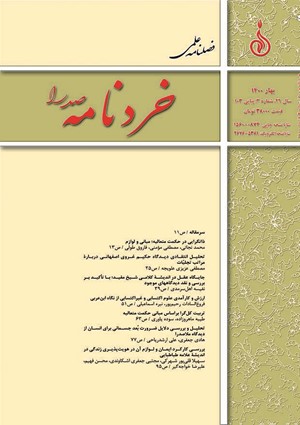تحليل انتقادي ديدگاه حكيم غروي اصفهاني دربارة مراتب تجليّات
محورهای موضوعی : پژوهش درباره فیلسوفان صدرایی و شارحان و منتقدان ملاصدرا
1 - دانشيار جامعةالمصطفي، قم، ايران
کلید واژه: تعيّن تجلي صرفالوجود وحدت شخصي وحدت تشكيكي غروي اصفهاني ,
چکیده مقاله :
يكي از ساحتهاي معرفتي حكيم غروياصفهاني، ديدگاه عرفاني و شهودي او در دو عرصة عملي و نظري است. محققاصفهاني بر پاية مباني حكمت متعاليه، ديدگاهي بديع در باب مراتب تعيّنات و تجليات حقتعالي مطرح نموده است؛ او بجاي «وحدت شخصي وجود» بر «وحدت تشكيكي وجود»، بجاي «تجلي و ظهورات» بر «وجود رابط و اضافة اشراقيه» و بجاي «اطلاق مقسمي» بر «بسيطالحقيقه و صرفالوجود» تأكيد دارد. حكيماصفهاني براي حقيقت وجود سه اعتبار و تعيّن ترسيم ميكند: الف) مرتبة «بشرط لا» از قيود عدمي يا صرفالوجود، ب) مرتبة «لا بشرط» از حدود امكاني يا فيض مقدس، ج) مرتبة «بشرط شيء» يعني اثر فعل حقتعالي. اين تقسيمبندي با آنچه در عرفان نظري مطرح است، متفاوت ميباشد. در اين پژوهش، ابتدا مراتب تجليات از ديدگاه محققاصفهاني تحليل ميشود و سپس مورد سنجش و ارزيابي قرار ميگيرد.
One of the epistemological innovations of Ḥakīm Gharawī Isfahānī entails his gnostic and intuitive approach in practice and theory. Based on the fundamental principles of the Transcendent Philosophy, Muḥaqqiq Isfahānī has proposed an innovative view regarding the levels of the determinations and manifestations of Almighty Truth. He emphasizes the “graded unity of existence” instead of the “individual unity of existence”, “copulative existence and illuminative relation” instead of “manifestations and epiphanies”, and “simple truth and pure existence” instead of “absoluteness of the source of division”. Ḥakīm Isfahānī introduces three specifications for the truth of existence: the “negatively conditioned” level of non-existential limits or pure existence, the level of “non-conditioned” from contingent limits or holy blessing, and the level of “conditioned-by-something” in the sense of the act of Almighty Truth. This division is different from the related division in theoretical gnosis. In this study, the author initially analyzes the levels of manifestations in the view of Muḥaqqiq Isfahānī and then evaluates them.
التركه، صائنالدين علي (1381) تمهيد القواعد، تصحيح حسن حسنزاده آملي، قم: الف لام ميم.
حسيني طهراني، سيدمحمدحسين (1419) توحيد علمي و عيني در مكاتيب حِكَمي و عرفاني، مشهد: مؤسسه ترجمه و نشر دوره علوم و معارف اسلام.
سبزواري، ملاهادي (1421ق) شرح المنظومه، تصحيح و تعليق حسن حسنزاده آملي، تهران: ناب.
غروي اصفهاني، محمدحسين (1389) كليات ديوان كمپاني، تصحيح محمد فربودي، قم: بقيةالله (عج).
غروي اصفهاني، محمدحسين (1390) تحفةالحكيم، ترجمه غلامرضا رحماني، قم: بوستان كتاب.
غروي اصفهاني، محمدحسين (1429) نهايةالدرايه، تحقيق ابوالحسن القائمي، قم: مؤسسه آلالبيت عليهم السلام لاحياء التراث.
قونوي، صدرالدين (1381) اعجاز البيان في تفسير أمّ القرآن، تصحيح سيدجلالالدين آشتياني، قم: بوستان كتاب.
ملاصدرا (1382) الشواهد الربوبيه في المناهج السلوكية، تصحيح و تحقيق سيدمصطفي محقق داماد، تهران: بنياد حكمت اسلامي صدرا.
ملاصدرا (1383) الحكمةالمتعالية في الاسفار الاربعة، ج1، تصحيح و تحقيق غلامرضا اعواني، تهران: بنياد حكمت اسلامي صدرا.
ملاصدرا (1386) ايقاظ النائمين، تصحيح و تحقيق محمد خوانساري، تهران: بنياد حكمت اسلامي صدرا.
ملاصدرا (1391) مجموعه رسائل فلسفي، تصحيح و تحقيق اصغر دادبه، تهران: بنياد حكمت اسلامي صدرا.
ملكي تبريزي، ميرزاجواد آقا (1380) رساله لقاء الله، بكوشش صادق حسن زاده، قم: آل علي عليهالسلام.


